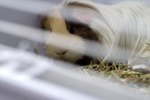Things You'll Need
Halter and lead
Elastic bandage
Iodine soap
Foaling stall
Bedding
Miniature donkeys are a small, sweet species of donkey hailing from the Mediterranean islands of Sicily and Sardinia. Standing less then 36 inches tall at the shoulder, miniature donkeys are docile creatures that take up considerably less space than their full-sized cousins, making them a popular choice for owners with a limited amount of land. Breeding miniature donkeys is a very rewarding experience, although it does take a bit of time and effort.
Select good representatives of the species before breeding. A miniature donkey should stand between 32 and 36 inches tall, have a long, deep ribcage and straight, wide hips for easy foaling. Your donkeys should also have firm, straight front legs that do not toe in or out and should have long, straight rear legs that do not turn in or out at the hocks.
Schedule an appointment with your veterinarian to have your male and female examined. Male donkeys are known as jacks and females are called jennets, so make sure both your jack and jennet are free of any communicable or genetic diseases before breeding them. Your jack and jennet should both be at least 3 years of age to make sure they are physically developed enough to prevent injuries during breeding and throughout the gestation process.
Catch both your jack and jennet and move them to a washing area to prepare them for breeding. Wrap your jennet’s tail with an elastic bandage to keep it out of the way during breeding. Wash the genital area of your jack and jennet with an iodine soap to cleanse the area and kill any bacteria that might be present.
Ask a helper to hold the jennet and allow your jack to sniff her in preparation for mating. If your jennet is receptive to his advances, she will move her tail to the side and allow him to mount her. Stand at the end of the lead to give your jack plenty of freedom to move during the breeding process. Separate your jack and jennet and remove her tail wrap before placing them back in their respective pens.
Keep your jennet fairly quiet during gestation. Miniature donkeys are pregnant for an average of 12 months, during which she should be allowed to lightly exercise but should not be worked too hard. Keep her on a normal feeding schedule until the last three months of her pregnancy, when you should increase her normal rations by approximately half to accommodate for the rapidly growing foal.
Move your jennet to a foaling stall in the last month of gestation. Your foaling stall should be deeply bedded with clean straw or shavings and should be located well away from any other animals that might disturb your jennet during labor. Your jennet may be unfriendly as labor approaches, and within 48 hours of birth, you will notice a swelling of the udder and a waxy buildup on the teats.
Observe your miniature donkey quietly as she goes into labor. She will pace her stall, stand up and lie down again, and roll in her stall as she prepares to give birth. Her water will break and the front legs and nose of the foal should appear. Her contractions will continue and push the remainder of the foal’s body out within an hour of her water breaking. If she strains for more than 15 or 20 minutes with no progress, call your veterinarian.
Allow your jennet to break the umbilical cord on her own and lick the foal clean after the birth. Licking helps the jennet and foal bond and stimulates milk production. Your new foal should stand soon after birth and begin nursing. If your jennet seems frightened or will not allow the foal near her, quietly enter the stall and hold the jennet still so your new miniature donkey foal can nurse.
Tips
Follow up with your vet within a few days of birth to have your jennet and foal examined. Your vet will make sure the foal is getting enough milk and will check your mare for any evidence of mastitis or a retained placenta.
Warnings
Never interfere with your jennet unless she is in trouble. Labor can be a lengthy process, but if you bother her during birth, your jennet may hold off contractions and stop labor, which can be harmful to her and the foal.
References
Photo Credits
-
donkey image by Marcin Karpeta from Fotolia.com
Writer Bio
Louise Lawson has been a published author and editor for more than 10 years. Lawson specializes in pet and food-related articles, utilizing her 15 years as a sous chef and as a dog breeder, handler and trainer to produce pieces for online and print publications.





